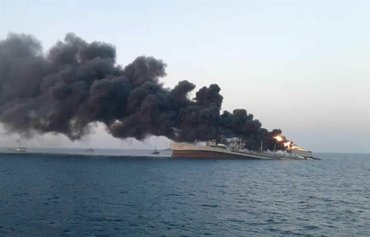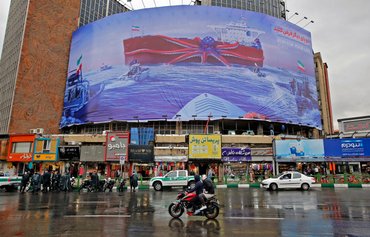Smoke from two fires that could be seen across the skyline in Iran on Thursday (June 3) was a physical manifestation of the growing problems and misplaced priorities of the Iranian regime.
One of Iran's largest naval ships sank Wednesday after catching fire while on a "training mission" off a strategic port near the head of the Gulf of Oman, the navy said.
In a separate incident, a huge blaze broke out early Wednesday evening at a major oil refinery in southern Tehran, responsible for providing the major part of the capital's fuel.
The refinery is located in a large industrial zone on Tehran's outskirts, only a few hundred metres from residential areas.
![An Iranian man checks a scorched gas station that was set ablaze by protesters during a demonstration against a rise in gasoline prices in Eslamshahr, near Tehran, on November 17, 2019. [AFP]](/cnmi_di/images/2021/06/03/30170-iran-gas-600_384.jpg)
An Iranian man checks a scorched gas station that was set ablaze by protesters during a demonstration against a rise in gasoline prices in Eslamshahr, near Tehran, on November 17, 2019. [AFP]
Intense flames and plumes of black smoke that were visible from far across the capital were gradually being brought under control several hours after the fire broke out.
However, early Thursday, the refinery was ablaze once again after local residents reported hearing a massive explosion.
Refinery spokesperson Shaker Khafaei denied rumours of fuel shortage in Tehran; however, photos from the capital Wednesday showed long lines of vehicles at gas stations, reflecting fear of fuel shortages.
In 2019, widespread protests over a hike in gasoline prices broke out across the country, followed by a brutal regime crackdown and several days of internet blackout.
One of Iran's largest navy ships sinks
In the Gulf, the British-built fleet replenishment vessel Kharg, which measured more than 200m long, caught fire on Tuesday off the port of Jask on the Gulf of Oman, the Iranian navy said.
Footage aired by state television showed a massive column of smoke rising from what it said was the burning vessel.
The fire broke out in "one of the systems" of the ship, a navy statement said without elaborating.
Firefighting efforts continued "for 20 hours" before the ship went down.
"Considering the spread of the fire, the mission to save the Kharg failed and it sank in waters off Jask," the navy stated.
The ship caught fire at 11am on Tuesday as it was in "domestic waters" during "a training mission", Iran's Tasnim news agency quoted the navy's head of public relations Behzad Jahanian as saying.
It sank around 8:30 a.m. on Wednesday.
All 400 cadets and crew disembarked safely, with 20 sustaining light injuries or burns.
Jahanian said the cause of the fire was "still not clear".
Jeremy Binnie, of open-source defence intelligence provider Janes, said the Kharg was important to Iran as its only dedicated vessel able to resupply warships at sea.
"The Iranians often describe it as a 'helicopter carrier', but it is actually a replenishment ship -– a useful asset nonetheless as it was the Islamic Republic of Iran Navy's only dedicated ship serving this role," Binnie said.
Iran's ISNA news agency said the vessel had left for a mission focused on "training, intelligence and combat" alongside the destroyer Alborz on May 19.
The port city of Jask, near which the Kharg went down, lies close to the Strait of Hormuz, the strategic chokepoint at the head of the Gulf through which a fifth of world oil output passes.
Jask is strategically important to Iran, as the government plans to make it the site of the country's second-largest oil export terminal.
Unlearned lessons
The last massive fire in Tehran occurred in January 2017 in the iconic commercial Plasco building, killing dozens of firefighters and sparking deep discontent after the failure to contain it, which was attributed to a shortage of equipment and lack of professional prowess in the fire department.
At the time, Iranian president Hassan Rouhani expressed hope that the Plasco tragedy would be "a lesson for the future."
The fire cost Mohammad-Bagher Ghalibaf, Tehran's mayor at the time, his bid for the presidency.
The government's misplaced priorities, lack of care for the public, and preference for the regional expansionist policies of the Islamic Revolutionary Guard Corps (IRGC) have caused preventable, occasionally fatal, incidents over the past few years both domestically and regionally.
On May 23, nine people were injured in a blast at a plant producing explosive materials in central Iran, local media reported, while three days later, a pipeline explosion at a petrochemical complex near Iran's Gulf coast left one dead.
In April, an explosion at Iran's Natanz uranium enrichment facility put the spotlight on the flaws of the Iranian regime's internal security.
The incident, like others in the past year, shows that Iran is unable to protect its most significant sources of self-proclaimed national pride.
The Natanz facility's blackout, caused by a deliberately planned explosion, has disabled Iran's uranium enrichment, preventing it from enriching uranium for months, the New York Times reported.
Last May, an Iranian warship was hit by friendly fire during a naval exercise off Jask, killing the 19 sailors onboard.
Logistical support vessel Konarak was hit after "moving a practice target to its destination and not creating enough distance between itself and the target," state television said at the time.
In another tragic incident in January 2020, Islamic Revolutionary Guard Corps (IRGC) shot down Ukraine International Airlines Flight 752 bound for Kyiv shortly after its takeoff from Tehran's Imam Khomeini international airport, a failure that cost the lives of everyone -- 176 civilians -- onboard.
After denying involvement for three days, Tehran admitted to shooting down the plane, blaming "human error" and calling the incident a "catastrophic mistake".
Misplaced priorities
The series of deadly mistakes in the course of a year brings into question the efficacy of Tehran's military strategy and the preparedness of the Iranian armed forces, analysts said.
"Instead of focusing on a capable military that can protect the Iranian state, the regime chooses to focus on militia activity, drones, and the development of ballistic and cruise missiles," Theodore Karasik, a senior adviser to Gulf State Analytics in Washington, DC, told Arab News last May, after the Jask incident.
The IRGC's focus on ideology over expertise has weakened it militarily, as evidenced by the US strike that killed its top military commander Qassem Soleimani in Baghdad in January 2020.
At home, the IRGC has been unable to protect sensitive military, nuclear and power plants from suspected acts of sabotage.

![A picture taken late on June 2 shows fire raging at an oil refinery in the Iranian capital Tehran. [Vahid Ahmadi/Tasnim News/AFP]](/cnmi_di/images/2021/06/03/30169-000_9ba8xa-600_384.jpg)






